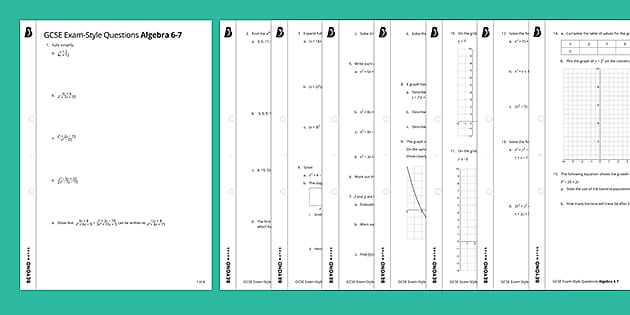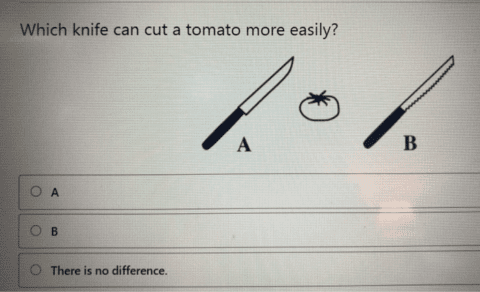Algebra FAQs & Linear Equation Solver
Linear Equation Solver (ax + b = cx + d)
Enter the coefficients and constants to solve for 'x':
General Algebra Questions
What is in Algebra 1?
Algebra 1 is typically the first course in a high school mathematics sequence that formally introduces students to algebra. Key topics usually include:
- Foundations of Algebra: Variables, expressions, order of operations, properties of real numbers.
- Solving Linear Equations: Single-variable equations, multi-step equations, equations with variables on both sides, literal equations (solving for a specific variable in a formula).
- Solving Linear Inequalities: Similar to equations, but with inequality symbols (<, >, ≤, ≥), and graphing solutions on a number line.
- Graphing Linear Equations and Functions: Slope, y-intercept, different forms of linear equations (slope-intercept, point-slope, standard), graphing lines, understanding function notation.
- Writing Linear Equations: Creating equations from given information (e.g., two points, a point and a slope).
- Systems of Linear Equations and Inequalities: Solving systems of two linear equations using graphing, substitution, or elimination methods. Graphing systems of linear inequalities.
- Exponents and Exponential Functions: Properties of exponents (multiplication, division, power of a power, negative exponents, zero exponent), scientific notation, introduction to exponential growth and decay.
- Polynomials and Factoring: Adding, subtracting, and multiplying polynomials. Factoring polynomials (GCF, difference of squares, trinomials).
- Quadratic Equations and Functions: Introduction to quadratic functions (parabolas), solving quadratic equations by factoring, using the quadratic formula, and sometimes by completing the square. Graphing basic parabolas.
- Radicals and Radical Expressions: Simplifying square roots, operations with radicals (sometimes).
- Data Analysis and Probability (often integrated): Basic statistics like mean, median, mode, and introduction to probability concepts.
The specific content can vary slightly by curriculum and region, but these are the core components.
How hard is Algebra 1?
The difficulty of Algebra 1 is subjective and depends on several factors:
- Prior Math Foundation: Students with a strong grasp of arithmetic (fractions, decimals, integers, order of operations – "basic math facts") tend to find Algebra 1 more manageable. Weaknesses in these areas can make algebra concepts harder to grasp.
- Abstract Thinking: Algebra introduces abstract concepts like variables and symbolic manipulation, which can be a shift from the more concrete nature of arithmetic. Some students adapt to this abstraction more quickly than others.
- Problem-Solving Skills: Algebra is heavily based on problem-solving. Students who enjoy puzzles and logical thinking might find it more engaging.
- Study Habits and Effort: Like any subject, consistent effort, doing homework, asking questions, and seeking help when needed significantly impact success and perceived difficulty.
- Teacher and Teaching Style: A good teacher who can explain concepts clearly and provide support can make a big difference.
- Learning Pace: Some students need more time to process new mathematical ideas.
For many, Algebra 1 is a challenging but rewarding course. It's a gateway to higher-level mathematics and is crucial for many STEM fields. It's not "hard" in the sense of being impossible, but it requires dedication and a willingness to learn new ways of thinking about numbers and relationships.
How to do algebra step by step?
While specific steps vary by problem type, a general approach to solving algebra problems often involves:
- Understand the Problem: Read the problem carefully. Identify what is given and what you need to find. Define your variables (e.g., let 'x' be the unknown number).
- Formulate an Equation (if it's a word problem): Translate the words and relationships into a mathematical equation or inequality.
- Simplify Expressions:
- Use the order of operations (PEMDAS/BODMAS: Parentheses/Brackets, Exponents/Orders, Multiplication/Division, Addition/Subtraction).
- Distribute if there are parentheses (e.g.,
a(b+c) = ab + ac). - Combine like terms (e.g.,
3x + 2x = 5x;7 - 4 = 3).
- Isolate the Variable (when solving equations/inequalities):
- The goal is to get the variable by itself on one side of the equation/inequality.
- Use inverse operations to "undo" what's being done to the variable.
- Addition undoes subtraction (and vice-versa).
- Multiplication undoes division (and vice-versa).
- Whatever operation you do to one side of the equation, you must do the same operation to the other side to maintain equality.
- Typically, deal with addition/subtraction terms first, then multiplication/division terms.
- Solve for the Variable: Perform the necessary calculations to find the value of the variable.
- Check Your Answer: Substitute your solution back into the original equation (or use the context of the word problem) to ensure it makes sense and is correct. This is a crucial step to catch errors.
- State Your Answer Clearly: Especially for word problems, answer the question asked, including units if applicable.
Example: Solve for x in 2x + 5 = 11
- Understand: We need to find the value of x.
- Equation is given.
- Simplify: No simplification needed on either side.
- Isolate x:
- Subtract 5 from both sides:
2x + 5 - 5 = 11 - 5=>2x = 6 - Divide both sides by 2:
2x / 2 = 6 / 2=>x = 3
- Subtract 5 from both sides:
- Solve:
x = 3 - Check:
2(3) + 5 = 6 + 5 = 11. The original equation was2x + 5 = 11, so11 = 11. It's correct.
What are the basic math facts?
Basic math facts refer to the results of simple arithmetic operations, primarily addition, subtraction, multiplication, and division, involving single-digit numbers (and sometimes up to 10 or 12 for multiplication/division). Mastery of these facts means being able to recall them quickly and accurately without needing to count or calculate extensively.
- Addition Facts: Sums of two single-digit numbers (e.g.,
3 + 5 = 8,9 + 7 = 16). - Subtraction Facts: Differences corresponding to addition facts (e.g.,
8 - 5 = 3,16 - 7 = 9). - Multiplication Facts: Products of two single-digit numbers (often learned as "times tables," e.g.,
4 × 6 = 24,7 × 8 = 56). Typically up to 10x10 or 12x12. - Division Facts: Quotients corresponding to multiplication facts (e.g.,
24 ÷ 6 = 4,56 ÷ 8 = 7).
Why are they important for algebra?
Fluency with basic math facts is crucial for success in algebra because:
- Reduces Cognitive Load: When students don't have to struggle to recall basic facts, they can focus their mental energy on understanding more complex algebraic concepts and procedures.
- Improves Speed and Efficiency: Solving multi-step algebra problems becomes much faster.
- Builds Confidence: Quick recall of facts helps students feel more confident in their mathematical abilities.
- Error Prevention: Mistakes in basic arithmetic can lead to incorrect answers in algebra, even if the algebraic steps are understood.
Where can I do math problems for free?
There are many excellent free resources available online for practicing and getting help with math problems:
- Khan Academy: Offers a vast library of video lessons, practice exercises, and quizzes for all levels of math, including algebra. It's completely free.
- IXL Learning (limited free practice): Provides comprehensive K-12 math practice. While it's a subscription service, it often offers a certain number of free problems per day.
- OpenStax: Publishes free, peer-reviewed, openly licensed textbooks for college and AP courses, including algebra. These often come with online resources and problem sets.
- SchoolYourself: Offers free interactive math lessons, similar to Khan Academy, with a focus on personalized learning.
- Mathway (limited free steps): Allows you to type in a problem and see the solution. Free version shows the answer; a subscription is needed for step-by-step solutions for many problem types.
- Symbolab (limited free steps): Similar to Mathway, provides step-by-step solutions for various math problems. Some features require a subscription.
- Wolfram Alpha (limited free steps): A powerful computational knowledge engine that can solve a wide range of math problems. While it can give answers, detailed step-by-step solutions often require a Pro subscription.
- Your local library: Often has textbooks, workbooks, and access to online learning databases.
- Educational YouTube Channels: Many educators create free video content explaining math concepts and solving problems (e.g., The Organic Chemistry Tutor, PatrickJMT, Math Antics).
Many schools also provide access to online math platforms for their students.
Specific Worksheet Queries
Regarding "Did you hear about..." and other specific worksheet answers (e.g., "Algebra with Pizzazz," "What is a metaphor algebra worksheet")
Queries like "did you hear about algebra worksheet answers," "what is a metaphor algebra worksheet," "why didn't the romans find algebra challenging worksheet answers," and many others in your list refer to specific, often copyrighted, educational worksheets. These worksheets frequently use riddles or puzzles where the answers to math problems spell out a funny phrase or answer a question (e.g., from series like "Algebra with Pizzazz" or "Punchline Algebra").
Unfortunately, providing direct answers to these specific copyrighted worksheets is generally not feasible or appropriate for a few reasons:
- Copyright: These materials are created by authors and publishers who own the rights to them.
- Educational Purpose: The goal of these worksheets is for students to practice and learn the mathematical concepts by working through the problems themselves. Simply providing answers defeats this purpose.
- Vast Number: There are thousands of such worksheets, and it's impossible to have a database of all their answers.
If you're working on such a worksheet and are stuck, here are some suggestions:
- Review the relevant concepts: Go back to your textbook, notes, or online resources (like Khan Academy) to understand the type of math problems on the worksheet.
- Try similar example problems: Work through examples that are similar to the ones you're struggling with.
- Ask your teacher for help: They are the best resource for understanding the material and can guide you through the problems.
- Collaborate with classmates (if permitted): Discussing problems with peers can often lead to understanding.
For queries like "a level algebra worksheets" or "a level maths algebra worksheets," these refer to materials for the A-Level curriculum (common in the UK). You can find resources for these by searching for "A-Level maths revision sites," "A-Level algebra practice problems," or through educational resource websites specific to the A-Level system.
COLLECTING LIKE TERMS (SIMPLIFYING EXPRESSIONS)
Using rules for like terms for addition, subtraction, multiplication and divsion.
THE RULES OF INDICES
EXPANDING BRACKETS (MULTIPLYING OUT BRACKETS)
FACTORING (FACTORISING ALGEBRAIC EXPRESSIONS)
ALGEBRAIC FRACTIONS
FORMULAE (SUBSTITUTION)
IDENTITIES
REARRANGING EQUATIONS (CHANGING THE SUBJECT OF A FORMULA)
SOLVING EQUATIONS (SOLVING LINEAR EQUATIONS WITH ONE UNKOWN)
SETTING UP AND SOLVING LINEAR EQUATIONS
QUADRATIC EQUATIONS AND EXPRESSIONS
SIMULTANEOUS EQUATIONS (LINEAR)
SIMULTANEOUS EQUATIONS (LINEAR AND NON-LINEAR)
SOLVING EQUATIONS GRAPHICALLY
SHADING INEQUALITIES (TWO VARIABLES)
NUMBER PATTERNS
NTH TERM OF A LINEAR (ARITHMETIC) SEQUENCE
QUADRATIC, GEOMETRIC, FIBONACCI AND GENERAL SEQUENCES
PLOTTING QUADRATIC (AND OTHER NON-LINEAR) GRAPHS
POLYNOMIAL AND EXPONENTIAL GRAPHS AND FUNCTIONS
GRAPHS OF TRIGONOMETRIC FUNCTIONS
LINE SEGMENTS (LENGTH AND MIDPOINT)
STRAIGHT LINE GRAPHS (LINEAR FUNCTIONS) Y= MX + C
PARALLEL AND PERPENDICULAR LINES (ALGEBRAICALLY)
GRAPH TRANSFOMATIONS
Translations and reflections. Stretches may well not appear on your exam spec!



